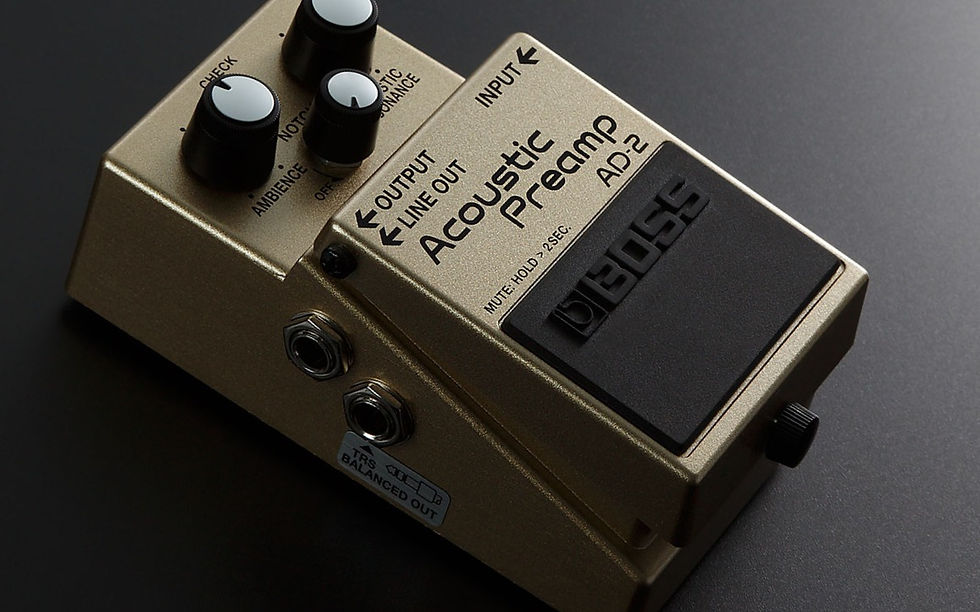Review: Kingsley Minstrel [v2]
- Nick Rambo
- Feb 14, 2020
- 3 min read
Updated: Nov 13, 2020

You’re probably obsessed with getting “tube tone” in a pedal, right? It’s a pretty safe bet, considering that the overwhelming majority of drive pedals on the market today really want to sound — and feel — like a good old-fashioned tube amp.
Just read the descriptions and marketing copy. It’s all in there.
Of course, this sentiment bleeds into the guitar forums and message boards I frequent, too. It seems like there’s always at least one thread near the top of the page about which stompbox would be best for replicating the tone and texture of authentic valve distortion.
So if this is something that interests you — and again, it probably is — I’ve got good news: the Kingsley Minstrel is literally a tube amp inside a pedal housing.
Keep It Real
I interviewed Simon Jarrett, owner of Kingsley Amplifiers and mastermind behind the Minstrel — and a variety of other tube-driven pedals — back in 2014 and he told me that a good tube circuit reacts to picking nuances, translates subtleties and feels good when you play.
“It’s hard to compete with the feel, dynamics and response of a great guitar plugged into a great amp," he said. "I am looking for the same experience when adding pedals.”
So in building the minstrel, Jarrett essentially put together a small, hand-wired tube amp with high-grade components on a tag board. Needless to say, the gutshot is a true wonder to behold. It features a single 12AX7 tube that’s pushed into overdrive by a FET transistor for some of the most authentically amp-like tones I’ve ever heard out of a stompbox. (And I’ve played a ton of them.)
The Details
Jarrett released an updated version of the Minstrel in December 2019, but for this review I played the second iteration of the pedal — the one without the new "More" switch that adds additional gain.
V2 and V3 use the same enclosure though, which was slightly smaller and more pedalboard friendly than the original, thanks to a more standard 9V power requirement (versus 12V requirement). And all versions feature a 3-band EQ that’s absolutely fantastic for shaping and tweaking your tone.
Word to the wise: start with the EQ knobs at noon. This doesn’t work with every pedal, but it’s the best starting point with this one.
The Minstrel features three modes that blend British and American tones with a hint of Dumble here and there. Mode one is the lightest overdrive, but there’s still a good amount of crunch if you crank the gain. Kicking into mode two adds more gain, thickness and a midrange punch that’s perfect for taking your guitar to the front of the mix for solos and leads. Of course, this can be tamed with the EQ knobs, but mode two is more midrange-forward overall. Switching to mode three adds even more saturation and a very pleasing sizzle. This mode is leaner, tighter and more aggressive than mode two — and harmonics just drip off the fretboard. It’s very awesome.
The Devil
Playing through this pedal feels and sounds like playing into a real amplifier. It’s that simple. And I know that’s something you’ll read a lot in overdrive reviews, but in the case of the Minstrel, it’s probably more true, because at its core, it is one.
Now, you’ll read pedal commentary on other pedals about how great the volume knob cleanup is or how the amp-like the touch responsiveness is, but in my journey to find a pedal that could do deliver a chimey low-gain grit as well as it could a thick high-gain chunk — the Minstrel delivers in a way that no pedal before it has. It’s really good.
Parting Shots
The Minstrel offers a lot of positives, but the 3-band EQ and array of gain modes are outstanding. Being able to dial in comprehensive range of realistic, high-quality drive tones is a delightful experience. But it is expensive — so be prepared to pony up some cash if you want one — and it needs a lot of juice, too. Even though it’s 9V, it requires 500mA of power, so be ready for that.
Note: This review was originally featured in Tone Report Weekly





Comments